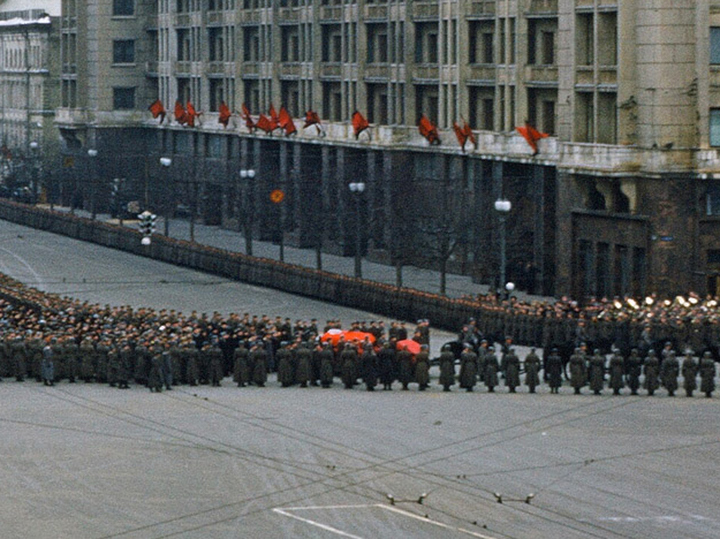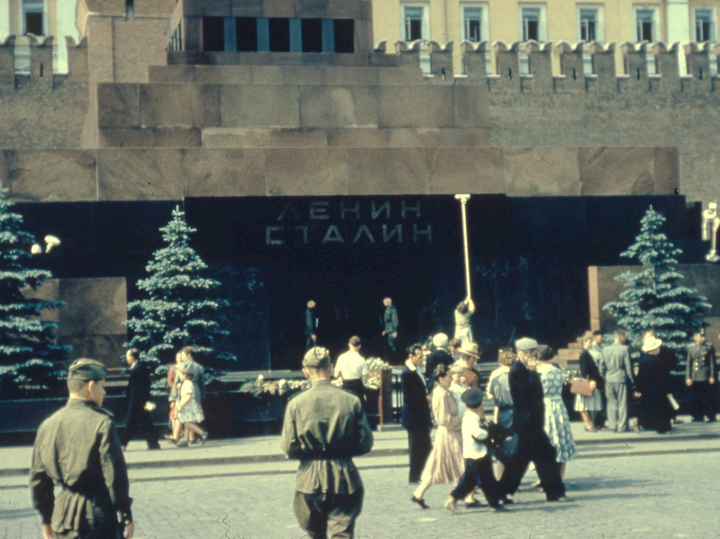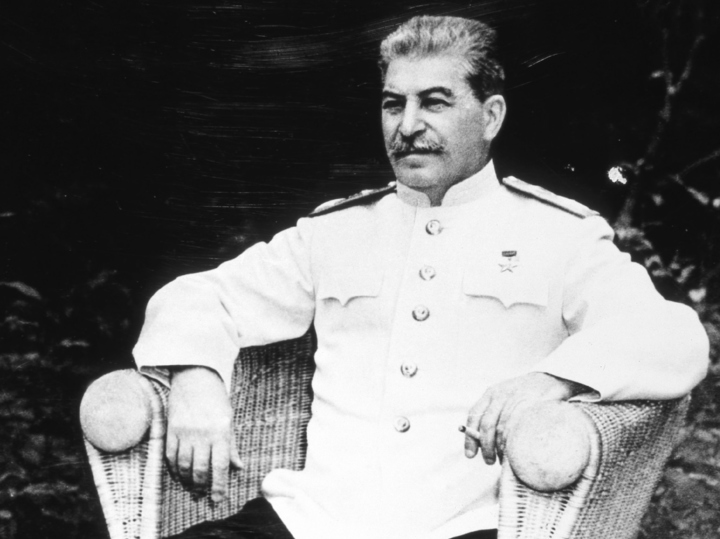How Stalin was buried: camouflage, Chekists, poems by the famous bard
[ad_1]
The decision that the embalmed body of Joseph Vissarionovich should be placed in the mausoleum next to Lenin was made in the party “top” of the country the day after the death of the “owner”, on March 6, 1953.
Nikita Khrushchev was entrusted with directing the funeral ceremony and organizing it. It was on his instructions that the scenario of the mourning action and the plan of all accompanying events were developed.
Farewell to the deceased “father of peoples” took place in the Hall of Columns of the House of the Unions for more than two days. At midnight on March 8, the access of citizens there was stopped, and from that moment preparations began for the transfer of the body to the mausoleum.
One of the very first procedures that had to be performed was purely technical: the Hall of Columns had to be freed from the numerous wreaths that filled it, brought here by delegations from the republics, regions, from metropolitan enterprises, organizations, educational institutions, theater groups …
According to the approved program of the ceremony, only 100 of the most “prestigious” wreaths were supposed to be carried behind the coffin of Stalin. The remaining several thousand were loaded onto trucks and transported to Red Square, where by morning they were neatly placed on both sides of the mausoleum, as well as along the Kremlin wall and the Historical Museum …
At dawn, units of the MGB troops arrived in the city center. Soldiers and officers by 7 o’clock in the morning lined up in two chains from the House of Unions to Red Square, forming a safe corridor for the movement of the funeral procession.
An hour later, “boxes” of the troops participating in the ceremony – 4400 people, as well as a military band, lined up on the main square of the country.
The area remaining behind the line of the living fence was filled with 12,000 “representatives of the working people” – a specially selected, reliable audience (according to the information that I heard from the direct participants in the events, almost half of these citizens were “comrades in civilian clothes”).

The mausoleum itself was also prepared for the upcoming ceremony. From the very beginning it was clear that the desire expressed by Khrushchev and his associates to replace the huge black slab of labrador above the entrance with the inscription “LENIN” with a new one – already with two surnames “LENIN STALIN” – was physically impossible to implement in such a short time. So I had to resort to camouflage. The monolith with the previous inscription was toned with a layer of black paint, adding bluish-silver “specks” to imitate natural stone. And on this background, a new, already double, inscription was made with crimson paint.
According to the testimonies of old-timers, such props turned out to be not of very high quality. During the onset of winter frosts, the plate was covered with hoarfrost and then the contours of the original “Lenin” inscription clearly appeared in the whitish layer formed. The huge stone block was replaced with a new one only at the turn of the 1960s. The fact is that all this time in the Kremlin “tops” considered the mausoleum as a temporary shelter for the bodies of the two most important communists embalmed “for centuries”. The mausoleum was to be replaced by a much more impressive structure.
On March 6, 1953, a decree was signed on the construction of a special Pantheon:
“In order to perpetuate the memory of the great leaders Vladimir Ilyich Lenin and Joseph Vissarionovich Stalin, as well as prominent figures of the Communist Party and the Soviet state, buried in Red Square near the Kremlin wall, to build in Moscow a monumental building – the Pantheon, a monument to the eternal glory of the great people of the Soviet country. Upon completion of the construction of the Pantheon, transfer to it the sarcophagus with the body of V.I. Lenin and the sarcophagus with the body of I.V. Stalin, as well as the remains of prominent figures of the Communist Party and the Soviet state buried near the Kremlin wall … “

The idea of such a pompous building existed for several years, but over time it somehow “resolved”. Then a new plate with inscriptions for the mausoleum was made, but it did not decorate this building for long.
Let us return, however, to the events of March 9, 1953. Their timing is carefully documented. There was a live broadcast of what was happening on the radio. The program was hosted by the “main voice of the country” – announcer Yuri Levitan.
The official ceremony of Stalin’s funeral began at 10.15 am, when the eight “main persons” of the USSR – G.M. Malenkov, L.P. Beria, V.M. Molotov, K.E. Voroshilov, N.S. Khrushchev, N.A. Bulganin, L.M. Kaganovich, A.I. Mikoyan, – in the Hall of Columns they lifted the coffin with the body of the “owner” and carried it to the exit. (Of course, it was difficult for even eight of the party hierarchs, who were by no means young and clearly not possessing outstanding physical condition, to keep a heavy domino on their weight, therefore, in order to avoid embarrassment, they were helped by several strong men in military uniform – state security officers).
After 8 minutes, the coffin was placed on a gun carriage, which was specially brought to the House of the Unions. After that, the funeral procession began, accompanied by Chopin’s Funeral March, performed by the orchestra. The procession proceeded along Okhotny Ryad, past the Moskva Hotel and the Historical Museum, to Red Square.
Numerous awards and regalia of the late Iosif Vissarionovich, which he did not like to wear during his lifetime (with the exception of the Golden Star of the Hero of Socialist Labor), were now carried on satin pillows by the country’s top military leaders. For example, the Marshal’s Star was carried by the legendary S.M. Budyonny, the Orders of Victory by Marshals Sokolovsky and Govorov, the Orders of Lenin by Marshals Konev, Timoshenko and Malinovsky … Members of the Presidium of the Central Committee, as well as members of the family of Iosif Vissarionovich, followed the gun carriage.
At 10.45, when the procession stopped at the mausoleum, the coffin was removed from the carriage and transferred to a special pedestal in front of the entrance to it. The highest party leaders, Soviet military leaders, as well as several leaders of the socialist states who specially arrived in Moscow, leaders of foreign communist parties climbed the podium of the mausoleum, and a mourning meeting began, which lasted almost an hour. Malenkov, Beria and Molotov made speeches.
At the end of this part of the ceremony, all the same eight high-ranking party members carried the coffin into the mausoleum and set it on the place already prepared for it there. Then an artillery salute went off.

At the initiative of Khrushchev, it was decided to celebrate the moment of Stalin’s burial in the mausoleum on an especially large scale. Exactly at noon on March 9, when this happened, the horns of factories and factories roared all over the country, steam locomotives on the railways, motor ships and steamers in the ports …
This was followed by a full five minutes of silence. When they passed, the troops assembled on the square marched in front of the mausoleum, and several military aircraft flew over it in parade formation.
If in the very heart of the capital the entire planned ritual went strictly according to plan and without obvious excesses, then outside the main cordon zone, order could not be maintained.
There, on the approaches to the center, thousands of inconsolable Muscovites gathered, who were eager to say goodbye to their beloved “leader and teacher.” In order to prevent unauthorized entry of citizens into the Red Square area, where the funeral ceremony took place, army barriers were set up on all the streets leading in its direction, sidewalks and pavements were blocked by trucks.
However, the organizers of the funeral did not properly take care of dispersing the crowd, avoiding a crush. As a result, we received a continuation of what was already happening in previous days, when people were rushing to the House of the Unions, hoping to “personally say goodbye to Stalin.” In several especially dangerous places, the townspeople again suffered from the pressure of a thousandth uncontrollable mass.
How many victims this terrible human press had then is not exactly known. Here is what the Moscow old-timer, historian Doctor of Sciences Alfred Mirek told the MK correspondent:
“Later, from my friend, who worked in the State Insurance, I learned that in total in those “funeral” days – at parting with Stalin and directly on March 9, 1,500 people died. Approximately the same number of wounded and crippled later died in hospitals. The last victims – two men trampled in a stampede – died six months later … By the way, the funerals of all these dead were paid for by the state … “
At the end, some more interesting facts related to the wires of Joseph Vissarionovich on his last journey.

The leader was placed in a coffin dressed in a military uniform, but by no means in a dress uniform. Stalin is wearing his favorite light tunic, which he often wore. For the funeral ceremony, they sewed on him the shoulder straps of the Generalissimo – during his lifetime, the Secretary General did not favor them, preferring that he had the old marshal’s shoulder straps on his shoulders. Two main medals were attached to the chest of the deceased – the Gold Stars of the Hero of the Soviet Union and the Hero of Socialist Labor.
The access of visitors to the mausoleum almost immediately after the ceremony, which took place on March 9, 1953, was stopped. This had to be done for technical reasons. After all, it was necessary to take care of the preservation of the body of the leader, and immediately after his death he was embalmed only in advance, so that he could endure a short farewell and funeral. Therefore, literally a day later, the coffin with Joseph Vissarionovich was transported to a secret laboratory, where specialists-embalmers worked on the deceased for almost three months. The mausoleum all this time, of course, was closed to the public.
It was the death of the “wise and caring” leader of the country, so loved by many, that prompted one of the ordinary Moscow schoolchildren to compose the first (but, as it turned out later, far from the last) poems in his life. Here is what an eighth-grader boy wrote on March 8, 1953:
“Girded with mourning ribbons,
Moscow plunged into silence,
Her grief for the leader is deep,
Sadness grips my heart…
The funeral march is pouring out
Violins groan and hearts groan,
I swear at the grave not to forget
Dear leader and father.
I swear I will keep up
With a friendly, strong and fraternal family,
I will carry a bright banner,
What did you give us, dear Stalin.
In these sad days
I swear at your grave
Do not spare the young of their forces
For my great Fatherland.
The name Stalin will live for centuries,
It will fly over the earth
The name Stalin will shine on us
Eternal sun and eternal star.
The name of the author of this poetic work is Vladimir Vysotsky. The same one.
[ad_2]
Source link








